Click on images to enlarge

infestation (Photo: Sheldon Navie)
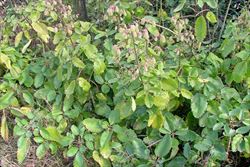
habit (Photo: Sheldon Navie)
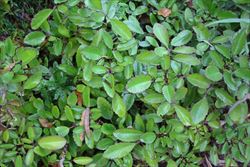
habit prior to flowering (Photo: Sheldon Navie)
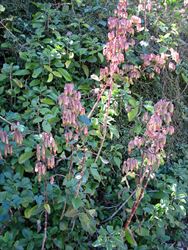
habit in flower (Photo: Sheldon Navie)
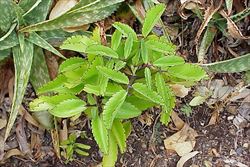
leaves (Photo: Sheldon Navie)
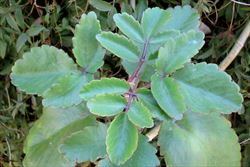
once-compound leaves with three or five leaflets (Photo: Sheldon Navie)
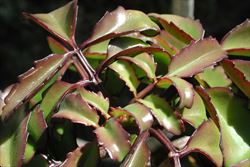
close-up of upper leaves (Photo: Sheldon Navie)
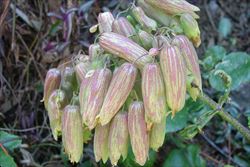
flower buds with colourful inflated calyx (Photo: Sheldon Navie)
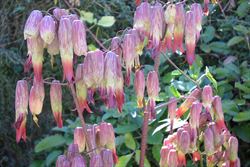
flower clusters (Photo: Sheldon Navie)
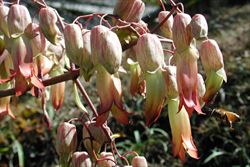
close-up of flowers (Photo: Sheldon Navie)
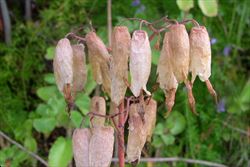
old flowers (Photo: Sheldon Navie)
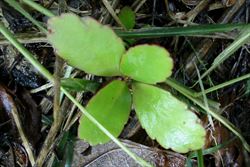
seedling with simple leaves (Photo: Sheldon Navie)
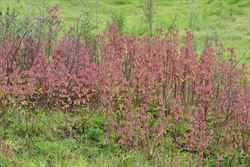
dense infestation in flower (Photo: Forest and Kim Starr, USGS)
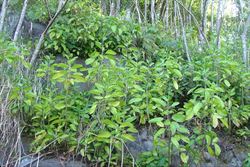
infestation on a cliff-face (Photo: Sheldon Navie)
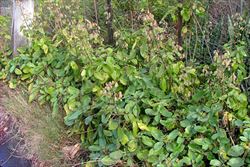
infestation growing along a roadside (Photo: Sheldon Navie)
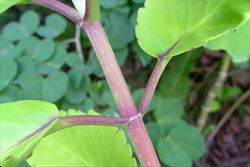
close-up of fleshy reddish stem with bases of paired leaves (Photo: Sheldon Navie)
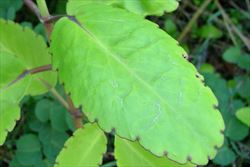
simple lower leaf with bluntly-toothed margins (Photo: Sheldon Navie)
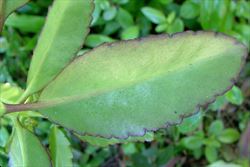
close-up of leaf underside (Photo: Sheldon Navie)
Scientific Name
Bryophyllum pinnatum (Lam.) Oken
Synonyms
Bryophyllum calycinum Salisb.Cotyledon pinnata Lam.Crassula pinnata L. f.Kalanchoe pinnata (Lam.) Pers.Sedum madagascaricum Clus.
Family
Crassulaceae
Common Names
air plant, airplant, Canterbury bells, cathedral bells, curtain plant, floppers, good luck leaf, green mother of millions, leaf of life, life plant, live leaf, live leaf plant, live plant, live-leaf, Mexican love plant, Mexican loveplant, miracle leaf, resurrection plant, sprouting leaf
Origin
Native to Madagascar and southern Africa.
Cultivation
Widely cultivated as a garden ornamental in Australia, and still be commonly seen growing in gardens.
Naturalised Distribution
A relatively widely naturalised species that is most common in the coastal regions of south-eastern Queensland and north-eastern New South Wales. It is also relatively common in the coastal regions of central and northern Queensland, present in other parts of New South Wales, and naturalised on several offshore islands (i.e. Lord Howe Island, Norfolk Island and the Cocos Islands).
Widely naturalised in other parts of the world including tropical eastern Africa, Asia (e.g. Taiwan, Indonesia and New Guinea), New Zealand, south-eastern USA (i.e. Florida), the Caribbean, and the Pacific (i.e. the Galapagos Islands, Melanesia, Polynesia and Hawaii).
Habitat
A garden escape that is naturalised in tropical, sub-tropical and warmer temperate regions. It is a weed of gardens, parks, roadsides, railways lines, waste areas, coastal environs, creek-banks, open woodlands, forests and forest margins.
Habit
A long-lived (i.e. perennial), fleshy (i.e. succulent) herbaceous plant with upright (i.e. erect) stems. It usually grows 30-120 cm tall, but can sometimes reach up to 2 m in height.
Distinguishing Features
- a fleshy upright plant usually growing 60-120 cm tall.
- its relatively broad leaves have scalloped margins and are oppositely arranged.
- these leaves may be simple or compound, with three or five leaflets.
- its drooping bell-shaped flowers are greenish-yellow to pinkish-red in colour (up to 7 cm long).
- these flowers are borne in branched clusters at the top of its stems.
Stems and Leaves
The upright (i.e. erect) stems are fleshy (i.e. succulent) and hairless (i.e. glabrous).
The leaves are also fleshy (i.e. succulent) and are either simple (particularly on seedlings) or compound (i.e. trifoliate or pinnate). They are oppositely arranged, flattened, and the number of leaflets present varies from one near the base of the stems to three or five (i.e. trifoliate or pinnate) higher up the stems. These leaves (5-25 cm long and 2-12.5 cm wide) are green or yellowish-green in colour, hairless (i.e. glabrous), and are borne on stalks (i.e. petioles) 2-10 cm long. The leaflets are oval or narrowly oval (i.e. elliptic) in shape with rounded tips (i.e. obtuse apices), and when more than one leaflet is present the end (i.e. terminal) leaflet is usually significantly larger than the others. Tiny plantlets may occasionally be formed in the scalloped (i.e. crenate) margins of these leaflets. These plantlets are more often produced if the leaves become detached from the stems.
Flowers and Fruit
The bell-shaped (i.e. tubular), drooping (i.e. pendulous), flowers (up to 7 cm long) are arranged in branched clusters at the tips of the stems (i.e. in terminal inflorescences). Each flower is borne on a stalk (i.e. pedicel) 10-25 mm long. They have prominent, inflated, yellowish-green or pale green coloured sepals (25-55 mm long) that are partially fused into a tube (i.e. calyx tube) and streaked with pink or reddish coloured blotches. The yellowish-green to dark red coloured petals (3-6 cm long) are also partially fused into a tube (i.e. a corolla tube) that divides into four petal lobes (i.e. corolla lobes) near the tip. Flowers are produced mainly during winter and spring.
The fruit are papery and membranous (about 15 mm long), with four slender compartments (i.e. carpels). They generally remain enclosed within the old flower parts and contain numerous minute, slender, brownish-coloured seeds (less than 1 mm long).
Reproduction and Dispersal
This plant reproduces by seed and also produces plantlets along the edges of its leaves. Its fleshy (i.e. succulent) leaves are capable of taking root and developing into new plants after being broken off the main plant or being dumped in garden waste.
Environmental Impact
Resurrection plant (Bryophyllum pinnatum) is an environmental weed in New South Wales and Queensland. It is regarded to be among the top 50 most invasive plant species in south-eastern Queensland and is on environmental weed lists for north-eastern New South Wales and the wider Sydney and Blue Mountains regions. It can form dense populations in natural habitats (i.e. in open woodlands and wetter forests, in coastal environs and along waterways) and these populations replace native species and prevent their regeneration.
Other Impacts
This species is thought to be poisonous to livestock and humans.
Legislation
This species is declared under legislation in the following states and territories:
- New South Wales: Class 3 - a regionally controlled weed. The relevant local control authority must be promptly notified of the presence of this weed and it must be fully and continuously suppressed and destroyed (Baulkham Hills, Blacktown, Cessnock, Clarence Valley, Dungog, Gloucester, Great Lakes, Greater Taree, Hawkesbury, Kempsey, Muswellbrook, Penrith, Port Macquarie-Hastings, Singleton and Upper Hunter local authority areas), and Class 4 - a locally controlled weed. The growth and spread of this species must be controlled according to the measures specified in a management plan published by the local control authority and the plant may not be sold, propagated or knowingly distributed (in the Campbelltown, Gosford, Gunnedah, Gwydir, Inverell, Lake Macquarie, Liverpool Plains, Moree Plains, Narrabri, Newcastle, Port Stephens, Tamworth, Tenterfield and Wyong local authority areas).
- Western Australia: Unassessed - this species is declared in other states or territories and is prohibited until assessed via a weed risk assessment (throughout the entire state).
Management
For information on the management of this species see the following resources:
- the Biosecurity Queensland Fact Sheet on mother of millions (Bryophyllum spp.), which is available online at http://www.dpi.qld.gov.au.
Similar Species
Resurrection plant (Bryophyllum pinnatum) is similar to lavender scallops (Bryophyllum fedtschenkoi) and relatively similar to mother-of-millions (Bryophyllum delagoense), hybrid mother-of-millions (Bryophyllum x houghtonii), mother-of-thousands (Bryophyllum daigremontianum) and prolific mother-of-millions (Bryophyllum proliferum). These species can be distinguished by the following differences:
- resurrection plant (Bryophyllum pinnatum) has large, broad, flattened, leaves (5-25 cm long and 20-125 mm wide) that are often compound (i.e. trifoliate or pinnate). These leaves are usually bright green or light green in colour have numerous blunt teeth along their margins (i.e. they are crenate).
- lavender scallops (Bryophyllum fedtschenkoi) has small, broad, flattened, leaves (12-50 mm long and 8-25 mm wide) that are always simple. These leaves are usually bluish-green or purplish-green in colour and have numerous reddish-brown coloured blunt teeth along their margins (i.e. they are crenate).
- mother-of-millions (Bryophyllum delagoense) has relatively small cylindrical (i.e. terete) leaves (usually less than 10 cm long and only 2-6 mm wide) that are always simple. These leaves are greyish in colour with some darker patches (i.e. they are variegated) and have a few teeth at their tips (i.e. apical notches).
- hybrid mother-of-millions (Bryophyllum x houghtonii) has relatively small boat-shaped or folded leaves (4-8 cm long and 8-20 mm wide) that are always simple. These leaves are greyish or greyish-green in colour with some darker patches (i.e. they are variegated) and have numerous teeth along their margins (i.e. marginal notches).
- mother-of-thousands (Bryophyllum daigremontianum) has relatively large boat-shaped or folded leaves (often more than 10 cm long and 25 mm wide) that are always simple. These leaves are greyish-green in colour with some darker patches (i.e. they are variegated) and have numerous teeth along their margins (i.e. marginal notches).
- prolific mother-of-millions (Bryophyllum proliferum) has relatively large compound (i.e. pinnate) leaves with 7-11 leaflets (7-5-15 cm long and about 3.5 cm wide). These greenish-coloured leaflets are somewhat elongated in shape, flattened, and have numerous blunt teeth along their margins (i.e. they are crenate).
Cotyledon (Cotyledon orbiculata) is also relatively similar to mother of millions (Bryophyllum delagoense). However, this species can be distinguished by its much broader, green or greyish, leaves that usually have a reddish-coloured margin.

